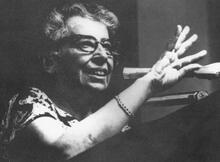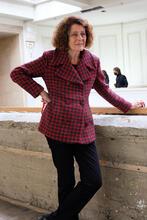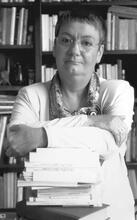Baroness Germaine de Rothschild
Germaine de Rothschild (née Halphen) was a noted philanthropist, accomplished musician, and author of two books. In 1905, she married the Baron Edouard de Rothschild, gaining a title and entry into France’s most eminent Jewish banking families. Germaine de Rothschild was active in philanthropic endeavors on behalf of Jewish children. After the rise of Nazism, her work took on a more political dimension. Most significantly, she orchestrated French Jewish efforts to evacuate Jewish children from Central Europe. Her “Comité Israélite pour les enfants venant d’Allemagne et d’Europe Centrale” helped provide refuge to 350-450 Jewish children. While in exile in New York, she advocated on their behalf, influencing the US Committee for the Care of European Children’s 1941 decision to evacuate refugee children from France to the United States.
Overview
“She was nobility, but noble of heart, who did everything so that we wouldn’t be intimidated. In my eyes, she was a queen. As soon as she got out of the car, we would jump into her arms and call her Tante Germaine. She would kiss us, like a protector, a good fairy, a good fairy straight out of a storybook, just for us” (Odette, 46, translated from the French).
This quotation from a Holocaust orphan describes Germaine de Rothschild, philanthropist, accomplished musician, recipient of the French legion of honor, author of two books, and mother of four (Alphonse, b. 1906; Guy, b. 1909; Jacqueline, b. 1911; and Bethsabée-Batsheva, b. 1914). As a member of one of France’s most privileged Jewish families, the daughter of Louise (née Fould) and Emile Halphen benefited from private tutoring and most likely did not receive an education outside her home. Her 1905 marriage to the Baron Edouard de Rothschild, which granted her the title of Baroness, was opposed by her own Jewish mother, who would have preferred her daughter to marry a Catholic, thus “completing” their assimilation into French society.
In their memoirs, Rothschild’s daughter Jacqueline painted her as a socialite, while her son Guy described her as an involved parent and philanthropist. They agree, however, that she was a self-assured and capable woman. Those who met her in the context of her activism on behalf of Jewish refugees would concur. The philosopher Hannah Arendt worked for the Baroness during her Paris exile. While a scathing critic of French Jewish leadership, Arendt liked the Baroness, even if she questioned the latter’s practice of visiting the orphanage bedecked in jewels and dressed in the signature Rothschild color (red), laden with gifts for the children. Another former employee recalled: “She was an intelligent woman, rather charming, and very capable of establishing human, personal, relationships” (Jablon, 65).
From Charity to Activism
“My mother initiated me into philanthropy,” wrote Rothschild’s mother, Louise Halphen, in her memoirs. “I started doing charitable work, which became for me an ever-growing passion” (Grange, 429). Halphen in turn introduced her daughter to philanthropy, which was an essential part of upper-class Jewish women’s identities in France. Nonetheless, there appears to have been a subtle difference between Halphen’s increasingly non-sectarian initiatives and those of her daughter: the mother’s charitable work was clearly part of her larger assimilatory project, while Germaine de Rothschild grew increasingly involved in Jewish causes, especially after the rise of Nazism. She was active during the French refugee crisis of the 1930s, employing a team of five or six social workers, as well as a head social worker, in order to assist thirty Jewish refugee families from Central Europe. While it is difficult to know exactly what accounted for the generational difference with her mother, it is possible that Germaine de Rothschild was influenced by her British friend Dorothy de Rothschild (née Pinto, wife of Jimmy de Rothschild), or that she perceived the gravity of the political situation.
While the Baroness left only a few written traces on her charitable work and her family’s accounts refer only in passing to her work for Jewish children, one could argue that her largest contributions were made on behalf of these children. Her commitment to their cause may have derived from the traumatic loss of her first son, Alphonse, who died of appendicitis in 1911 at the age of four. Even before the refugee crisis, Germaine de Rothschild seems to have played an important role in the Rothschild orphanage, in addition to funding a center for poor Jewish children in Belleville, most likely through her aid organization for Jewish youth, Beneï Israël—Centres sociaux pour la jeunesse juive (Children of Israel: Social Centers for Jewish Youth). She also played a significant role encouraging sports for Jewish children through the Union des oeuvres de la jeunesse israélite pour l’éducation physique (Union for the Physical Education of Jewish Youth), established in 1924.
Orchestrating Kindertransport to France
Most significantly, Germaine de Rothschild led French efforts to evacuate Jewish children from Central Europe after the March 1938 annexation of Austria and the November 1938 pogrom that became widely known as Kristallnacht. In March 1938, two Austrian Jewish women began looking for a new home for girls from the Merores Jewish orphanage in Vienna, and they received a positive response from the Rothschild orphanage in mid-July 1938. By the end of that month, the Baroness de Rothschild had agreed to accept an additional twenty young girls who would be placed in apprenticeship programs and fully supported by her organization, Beneï Israël—Centres sociaux pour la jeunesse juive. It appears that ten girls actually came to France. However, by December 1938, the Baroness was ready to take her activism on behalf of German and Austrian Jewish families to a new level. She sought permission from the French government for fifty children to enter France under her sponsorship; permission was granted on an exceptional basis.
In January 1939, Rothschild established the Comité Israélite pour les enfants venant d’Allemagne et d’Europe Centrale (CIE; Jewish Committee for German and Eastern European children). This committee helped between 350 and 450 Jewish children by organizing transports to France and helping children who had crossed into France illegally. The parallel with British Kindertransport is not accidental. The Baroness, who spent World War I in England, echoed the activities of her confidante Dorothy de Rothschild, who evacuated Central European Jewish children to the Rothschilds’ Waddesdon Manor, just north of London.
On January 31, 1939, the CIE obtained 200 visas to bring children to France, and it most likely received an additional 40 visas before the outbreak of the war. The Committee’s leadership drew from elite Jewish circles, including the Baroness as president; Pierre Dreyfus, son of Captain Alfred Dreyfus, and the Baroness Claude de Rothschild (née Dupont) as vice-presidents; Susanne Schreiber-Crémieux as secretary general; and Germaine de Rothschild’s son, Baron Guy de Rothschild, as treasurer. The Baroness hired a 30-year-old Jewish refugee, Robert Jablonski (later Jablon), to run its operations. With his legal training, experience in international patent law, and mastery of German and French, Jablonski had the skills needed to navigate the complex administrative procedures involved in evacuating children.
With Robert Jablonski taking care of logistics, Germaine de Rothschild was free to turn the Rothschilds’ hunting property in Villeneuve-Saint-Denis, the Château de la Guette, into a first-class children’s home. The children began arriving in March 1939. The château made a lasting impression on Viennese social worker Trude Frankl, who escorted Austrian Jewish children all over Europe with the hope of finding safe havens for her wards. The children were equally impressed. One of its new inhabitants simply wrote, upon arrival, “Es ist Wunderbar (It is wonderful)” (Heinz Löw diary, USHMM). The chateau’s design reflected a certain commitment to progressive education methods. As reflected in the its miniature home-economics department, the children learned both inside and outside of the classroom.
The Château de la Guette, however, would prove to be only a temporary home for the children, who were forced to flee south after the Nazi invasion of France in May 1940. The French banking industry reestablished itself in the small spa town in Auvergne, La Bourboule, as did the Rothschild family and the refugee children. However, the Rothschild family, an early target of the Vichy regime, fled to New York in July 1940. The Baroness made a splash by arriving with a million dollars-worth of jewelry.
Exile in New York
Once in New York, Germaine de Rothschild continued her activism for the refugee children, writing to the Joint Distribution Committee to ask if something could be done for them: “It seems dreadful for these unhappy children!” (JDC archive, Letter from Rothschild to Troper, 1940). Remaining active on behalf of refugee children in the United States allowed the Baroness to continue the work she had begun in France. She soon accepted the National Refugee Service’s request to head a new committee on summer placement for refugee children. She also stayed busy by accepting a new challenge: speaking at American Jewish fundraising events.
Through migration from France to the United States, Germaine de Rothschild’s place in Jewish life evolved from behind-the-scenes philanthropist to public figure. In France, the Baroness had not made speeches to thousands of individuals, let alone in a foreign language. By March 1941, this new public role had brought her into contact with First Lady Eleanor Roosevelt. Meeting Roosevelt was no small event for the Baroness, who seemed somewhat intimidated by the First Lady, yet was perhaps even more surprised at her own public speaking skills: “Sometimes, like last week, I am very busy. Other weeks, less so. Last week I spoke three times and Madame Roosevelt was at one of the receptions for Youth Aliyah. I chatted for 10 minutes!! Without any accidents. Tomorrow I have yet another function which now seem part of my life [...] for the United Jewish Appeal. Everyone is charming and displaying an indulgence that I would perhaps not find in Europe. Let’s enjoy it! [Profitons en!]” (Rothschild Archive, Waddesdon Manor, Letter from Germaine de Rothschild to Dorothy de Rothschild, April 28, 1941, translated from French). Indeed, as she precisely noted, the “charm and indulgence” she found in New York led the Baroness to take on a new and exhilarating role, allowing her to cultivate a relationship with the First Lady. This relationship was especially significant because Eleonor Roosevelt was the honorary president of the United States Committee for the Care of European Children, an organization established in June 1940 to evacuate children from the United Kingdom.
As early as October 1940, the Baroness provided a firsthand account of the plight of the La Guette refugee children to board of the United States Committee for the Care of European Children, which she surely reiterated when she spoke with Eleanor Roosevelt. Rothschild thus most likely influenced the United States Committee’s February 1941 decision to evacuate refugee children from France. A complex collaboration ensued, including the Quaker American Friends Service Committee and the Jewish organizations OSE and the Joint Distribution Committee, which organized several transports of children that left France in 1941-1942 for the United States, via Spain, Portugal, and Morocco. From 1942 through the end of hostilities, the transports continued from Portugal. In total, roughly 300 refugee children were saved in this manner, including just over 250 Jewish children, many whom had come to France on the Kindertransports initiated by the Baroness. Thanks to the efforts of multiple individuals and organizations, these children escaped occupied Europe, which had become a trap for all Jewish children. Some Kindertransport children were not as lucky, however. At least ten refugee children from the Château de la Guette were deported to Nazi death camps, where all but one perished.
Return to France
At the war’s end, the Baroness returned to France and remained active in the lives of Jewish Holocaust orphans, who continued to be cared for at the Château de la Guette. She also authored two books, one on a sixteenth-century Protestant potter, published in 1952, and a second on the Italian composer Luigi Boccherini, in 1962. She passed away on January 1, 1975, just before her 91st birthday, and is buried in the Père Lachaise cemetery in Paris. Unlike her mother and her children, she did not write her memoirs, leaving many gaps for historians who seek, nonetheless, to document her lasting accomplishments.
Les Enfants de La Guette. Souvenirs et Documents (1938-1945). Paris: Centre de Documentation Juive Contemporaine, 1999.
Grange, Cyril. Une Élite Parisienne: Les Familles de La Grande Bourgeoisie Juive (1870-1939). Cahiers Alberto-Benveniste. Paris: CNRS éditions, 2016.
Hobson Faure, Laura. “Becoming Refugees: The Migrations of Central European Jewish Children Through France to the United States, 1938-1942.” Habilitation à diriger des recherches, Paris: Sciences Po Paris, 2018.
Jablon, Robert, Laure Quennouëlle-Corre, and André Straus. Politique et Finance à Travers l’Europe Du XXe Siècle: Entretiens Avec Robert Jablon. Enjeux Internationaux 7. Brussels: P. Lang, 2009.
Loinger, Georges, and Katy Hazan. Aux frontières de l’espoir. Paris: Fondation pour la mémoire de la Shoah : Editions le Manuscrit, 2006.
Odette. Orpheline de La Shoah. Paris: Presses de la Renaissance, 2005.
Pénard, Etienne. “Le ‘peuple du livre’ à l’épreuve du ‘judaïsme du muscle’: les communautés juives de France et le sport (fin XIXé-1948).” PhD dissertation, Université de Rennes-2, November 2020.
Piatigorsky, Jacqueline. Jump in the Waves: A Memoir. New York: St. Martin’s Press, 1988.
Rothschild, Guy. The Whims of Fortune: The Memoirs of Guy de Rothschild. New York: Random House, 1985.
Rothschild, Germaine. Bernard Palissy et Son École (Collection Edouard de Rothschild). Paris: Au pont des arts, 1952.
Rothschild, Germaine. Luigi Boccherini, Sa Vie, Son Œuvre. Paris: Plon, 1962.
“Rothschild’s Bring $1,000,000,000 in Gems: Notables and Jewels Here from Europe on a Yankee Clipper.” The New York Times, July 11, 1940.
Young-Bruehl, Elisabeth. Hannah Arendt, For the Love of the World. New Haven: Yale University Press, 1982.
Archival sources include:
Alliance Israélite Universelle, Procès Verbaux, Central Committee.
Mémorial de la Shoah, Werner Matzdorff Collection (1528) and Félix Chevrier Collection (CCCLXXIII).
United States Holocaust Memorial Museum, Archive of the Jewish Community of Vienna-Jerusalem Component Collection, A/W 1985 (RG 17.017).
Oeuvre de Secours aux Enfants Archives, Paris Headquarters, Andrée Salomon collection.
American Jewish Joint Distribution Committee Archive-New York, AR 1933-44, Files 189 and 610.
University of Michigan, Bentley Historical Library, William Haber Papers.
Rothschild Archive, Waddesdon Manor, Dorothy de Rothschild Collection.









